The Muscle Relaxant Drugs Market is estimated to be valued at USD 4.9 billion in 2025 and is projected to reach USD 9.2 billion by 2035, registering a compound annual growth rate (CAGR) of 6.4% over the forecast period.
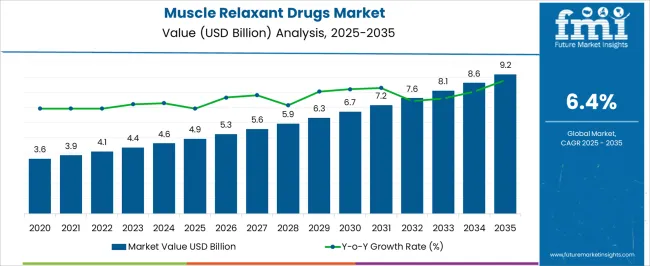
| Metric | Value |
|---|---|
| Muscle Relaxant Drugs Market Estimated Value in (2025 E) | USD 4.9 billion |
| Muscle Relaxant Drugs Market Forecast Value in (2035 F) | USD 9.2 billion |
| Forecast CAGR (2025 to 2035) | 6.4% |
The Muscle Relaxant Drugs market is expanding steadily, supported by the increasing prevalence of musculoskeletal disorders, chronic pain, and conditions associated with aging populations. Rising incidences of back pain, arthritis, fibromyalgia, and sports-related injuries are generating consistent demand for effective muscle relaxants across healthcare systems. Advances in drug formulation, coupled with expanded clinical research into neuromuscular conditions, are shaping therapeutic options and driving innovation in this sector.
Growing awareness regarding early diagnosis and treatment of musculoskeletal conditions, along with the rising burden of sedentary lifestyles, is further fueling market growth. Hospitals and clinics are increasingly adopting advanced relaxants in both acute and chronic care settings, while retail pharmacies continue to serve as a key distribution channel. Regulatory approvals for improved formulations with better safety profiles are also positively impacting adoption rates.
Furthermore, the growing interest in targeted therapies and integration of muscle relaxants within multimodal pain management strategies are enhancing treatment effectiveness With healthcare systems focusing on cost efficiency and patient outcomes, the muscle relaxant drugs market is anticipated to sustain long-term growth, particularly as global healthcare infrastructure continues to evolve.
The muscle relaxant drugs market is segmented by product type, formulation, retail sales channel, and geographic regions. By product type, muscle relaxant drugs market is divided into Peripherally Acting Muscle Relaxants, Neuromuscular Blocking Agents, Direct Acting Muscle Relaxants, Facial Aesthetic Relaxants, and Centrally Acting Muscle Relaxants. In terms of formulation, muscle relaxant drugs market is classified into Solid Oral Formulations and Injectable Formulations. Based on retail sales channel, muscle relaxant drugs market is segmented into Hospital Pharmacy, Online Sales, Retail Pharmacy, and Drug Stores. Regionally, the muscle relaxant drugs industry is classified into North America, Latin America, Western Europe, Eastern Europe, Balkan & Baltic Countries, Russia & Belarus, Central Asia, East Asia, South Asia & Pacific, and the Middle East & Africa.
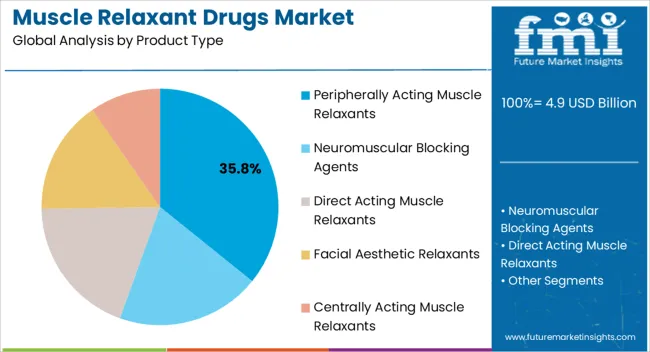
The peripherally acting muscle relaxants segment is projected to hold 35.8% of the market revenue share in 2025, positioning it as a leading product type. Growth in this segment is attributed to its established efficacy in surgical settings, intensive care units, and chronic musculoskeletal disorder treatments. These drugs work by directly targeting skeletal muscle function rather than central nervous system pathways, reducing adverse neurological side effects and improving patient tolerance.
They are commonly used in anesthesia to facilitate intubation and surgical procedures, as well as in long-term care for conditions involving spasticity. Their reliability in producing predictable results has made them a preferred choice among clinicians in both hospital and specialty care settings. Technological progress in drug delivery and clinical research supporting safer long-term usage are further reinforcing demand.
The increasing frequency of orthopedic surgeries, coupled with growing aging populations requiring musculoskeletal care, continues to enhance adoption of these drugs As demand for safer and more effective therapeutic solutions increases globally, peripherally acting muscle relaxants are expected to maintain a strong position in the market.
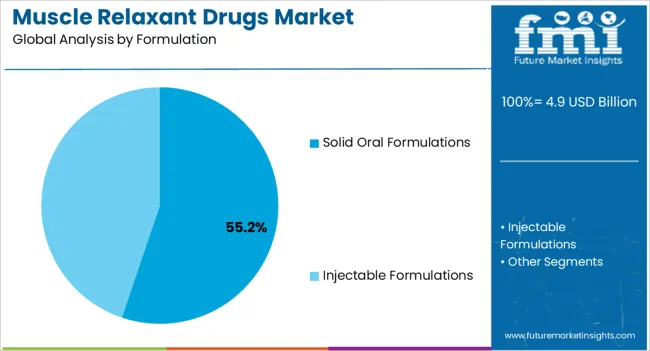
The solid oral formulations segment is expected to account for 55.2% of the muscle relaxant drugs market revenue in 2025, making it the dominant formulation type. This leadership is being driven by the convenience, affordability, and widespread acceptance of oral dosage forms among patients and healthcare providers. Solid oral formulations are easy to administer, allow for controlled dosing, and demonstrate stable pharmacokinetics, which enhance patient adherence to treatment regimens.
Their cost-effectiveness compared to injectables or advanced delivery mechanisms makes them particularly suitable for large-scale prescription in outpatient settings. Additionally, oral formulations support long-term management of chronic musculoskeletal conditions such as back pain, arthritis, and fibromyalgia, where consistent treatment is essential. The well-established distribution channels for tablets and capsules through retail and hospital pharmacies are further strengthening market reach.
Continuous improvements in drug formulation, including extended-release versions designed for sustained therapeutic effects, are boosting their clinical value As healthcare systems prioritize patient-friendly treatment methods, solid oral formulations are expected to retain their dominant market share, supported by both clinical utility and cost-efficiency.
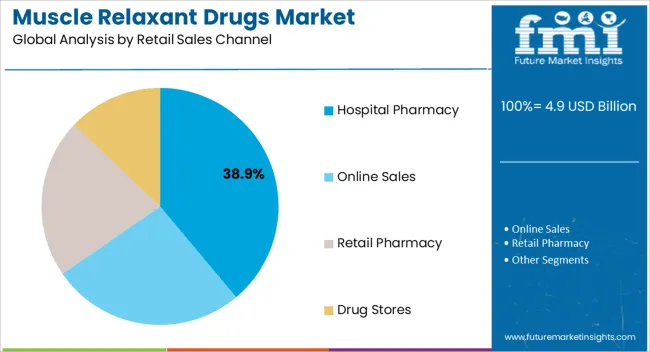
The hospital pharmacy segment is anticipated to secure 38.9% of the market revenue share in 2025, positioning it as a major retail sales channel. Growth in this segment is being supported by the rising use of muscle relaxants in acute care, surgical interventions, and emergency treatments, where hospital pharmacies serve as the primary dispensing points. Hospitals remain critical hubs for administering peripherally acting relaxants during surgical procedures and centrally acting relaxants in post-operative care.
The ability of hospital pharmacies to ensure drug availability, quality control, and regulatory compliance strengthens their importance in this market. Moreover, hospital-based pharmacists often play a role in monitoring drug interactions and optimizing dosages, which enhances treatment safety and efficacy. Increasing hospital admissions due to orthopedic surgeries, trauma cases, and age-related musculoskeletal disorders is driving demand in this channel.
With hospitals integrating advanced pain management protocols, the reliance on hospital pharmacies for effective muscle relaxant supply is expected to grow As healthcare infrastructure expands and surgical volumes increase, hospital pharmacies will remain a vital component of the market’s distribution network.
Muscle relaxant drugs are primarily used in conjunction with general anesthetics to achieve muscle relaxation during surgical interventions. However, they are also being used in the treatment of muscle spasm and spastic neurological conditions secondary to multiple sclerosis, cerebral palsy, fibromyalgia, myofascial pain syndrome etc.
Muscle relaxants can be used in alleviating acute pain in muscle spasm, tension headache etc. Spasticity arises from conditions affecting brain and spinal cord, and lasts for a long time. However, muscle relaxant drugs only provide symptomatic treatment and do not cure the underlying disease or disorder.
Loss of muscle tone associated with old age, due to loss of fibrous tissue and reduced vascular network in the skin makes old age population the biggest target group for the use of skeletal muscle relaxant drugs.
Moreover, geriatric population is highly prone to the musculoskeletal disorders including Carpal Tunnel syndrome, ligament sprain etc. relaxant drugs are commercially being used from 1940s, and since 1995, 10 new muscle relaxant drugs have been introduced in a market including vecuronium, Atracurium etc.
Some of the commonly used brands of skeletal muscle relaxant drugs include Gablofen (baclofen injection), Lioresal Intrathecal (baclofen), Soma (Carisoprodol), Lorzone (Chlorzoxazone), Flexeril (Cyclobenzaprine), Dantrium (Dantrolene), Skelaxin (Metaxalone) and others. According to the Medicaid reported data, carisoprodol, cyclobenzaprine and metaxalone comprised 45% of overall prescription for lower back pain in the USA in 2025.
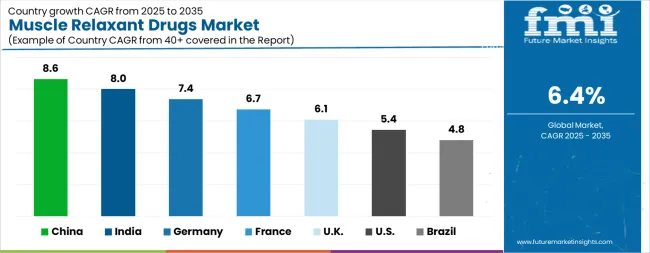
| Country | CAGR |
|---|---|
| China | 8.6% |
| India | 8.0% |
| Germany | 7.4% |
| France | 6.7% |
| UK | 6.1% |
| USA | 5.4% |
| Brazil | 4.8% |
The Muscle Relaxant Drugs Market is expected to register a CAGR of 6.4% during the forecast period, exhibiting varied country level momentum. China leads with the highest CAGR of 8.6%, followed by India at 8.0%. Developed markets such as Germany, France, and the UK continue to expand steadily, while the USA is likely to grow at consistent rates. Brazil posts the lowest CAGR at 4.8%, yet still underscores a broadly positive trajectory for the global Muscle Relaxant Drugs Market. In 2024, Germany held a dominant revenue in the Western Europe market and is expected to grow with a CAGR of 7.4%. The USA Muscle Relaxant Drugs Market is estimated to be valued at USD 1.8 billion in 2025 and is anticipated to reach a valuation of USD 3.1 billion by 2035. Sales are projected to rise at a CAGR of 5.4% over the forecast period between 2025 and 2035. While Japan and South Korea markets are estimated to be valued at USD 267.6 million and USD 133.0 million respectively in 2025.
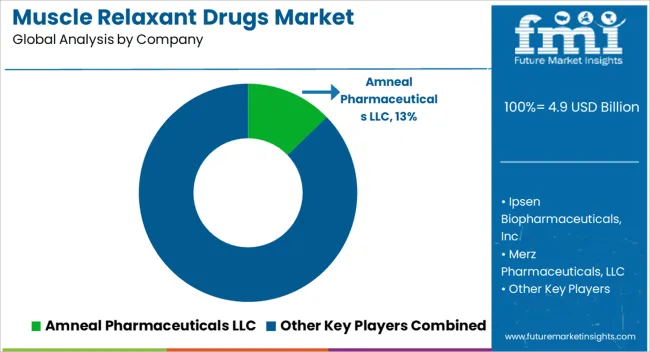
| Item | Value |
|---|---|
| Quantitative Units | USD 4.9 Billion |
| Product Type | Peripherally Acting Muscle Relaxants, Neuromuscular Blocking Agents, Direct Acting Muscle Relaxants, Facial Aesthetic Relaxants, and Centrally Acting Muscle Relaxants |
| Formulation | Solid Oral Formulations and Injectable Formulations |
| Retail Sales Channel | Hospital Pharmacy, Online Sales, Retail Pharmacy, and Drug Stores |
| Regions Covered | North America, Europe, Asia-Pacific, Latin America, Middle East & Africa |
| Country Covered | United States, Canada, Germany, France, United Kingdom, China, Japan, India, Brazil, South Africa |
| Key Companies Profiled | Amneal Pharmaceuticals LLC, Ipsen Biopharmaceuticals, Inc, Merz Pharmaceuticals, LLC, Mylan (Viatris), Sanofi, Pfizer Inc, Novartis AG, eva Pharmaceuticals Industries Ltd, Inc, Vertical Pharmaceuticals, Sun Pharmaceutical Industries Ltd, SteriMax Inc, Par Pharmaceutical, Abbott Laboratories, and F. Hoffmann-La Roche AG |
The global muscle relaxant drugs market is estimated to be valued at USD 4.9 billion in 2025.
The market size for the muscle relaxant drugs market is projected to reach USD 9.2 billion by 2035.
The muscle relaxant drugs market is expected to grow at a 6.4% CAGR between 2025 and 2035.
The key product types in muscle relaxant drugs market are peripherally acting muscle relaxants, neuromuscular blocking agents, direct acting muscle relaxants, facial aesthetic relaxants and centrally acting muscle relaxants.
In terms of formulation, solid oral formulations segment to command 55.2% share in the muscle relaxant drugs market in 2025.






Our Research Products

The "Full Research Suite" delivers actionable market intel, deep dives on markets or technologies, so clients act faster, cut risk, and unlock growth.

The Leaderboard benchmarks and ranks top vendors, classifying them as Established Leaders, Leading Challengers, or Disruptors & Challengers.

Locates where complements amplify value and substitutes erode it, forecasting net impact by horizon

We deliver granular, decision-grade intel: market sizing, 5-year forecasts, pricing, adoption, usage, revenue, and operational KPIs—plus competitor tracking, regulation, and value chains—across 60 countries broadly.

Spot the shifts before they hit your P&L. We track inflection points, adoption curves, pricing moves, and ecosystem plays to show where demand is heading, why it is changing, and what to do next across high-growth markets and disruptive tech

Real-time reads of user behavior. We track shifting priorities, perceptions of today’s and next-gen services, and provider experience, then pace how fast tech moves from trial to adoption, blending buyer, consumer, and channel inputs with social signals (#WhySwitch, #UX).

Partner with our analyst team to build a custom report designed around your business priorities. From analysing market trends to assessing competitors or crafting bespoke datasets, we tailor insights to your needs.
Supplier Intelligence
Discovery & Profiling
Capacity & Footprint
Performance & Risk
Compliance & Governance
Commercial Readiness
Who Supplies Whom
Scorecards & Shortlists
Playbooks & Docs
Category Intelligence
Definition & Scope
Demand & Use Cases
Cost Drivers
Market Structure
Supply Chain Map
Trade & Policy
Operating Norms
Deliverables
Buyer Intelligence
Account Basics
Spend & Scope
Procurement Model
Vendor Requirements
Terms & Policies
Entry Strategy
Pain Points & Triggers
Outputs
Pricing Analysis
Benchmarks
Trends
Should-Cost
Indexation
Landed Cost
Commercial Terms
Deliverables
Brand Analysis
Positioning & Value Prop
Share & Presence
Customer Evidence
Go-to-Market
Digital & Reputation
Compliance & Trust
KPIs & Gaps
Outputs
Full Research Suite comprises of:
Market outlook & trends analysis
Interviews & case studies
Strategic recommendations
Vendor profiles & capabilities analysis
5-year forecasts
8 regions and 60+ country-level data splits
Market segment data splits
12 months of continuous data updates
DELIVERED AS:
PDF EXCEL ONLINE
Muscle Relaxing Creams Market Size and Share Forecast Outlook 2025 to 2035
Muscle Oxygen Monitors Market Size and Share Forecast Outlook 2025 to 2035
Muscle Stimulator Market Size and Share Forecast Outlook 2025 to 2035
Drugs Glass Packaging Market Analysis - Size, Share, and Forecast Outlook 2025 to 2035
Muscle Tension Dysphonia Treatment Market - Trends, Growth & Forecast 2025 to 2035
The Muscle Stimulation Devices Market is segmented by Product, Application and End User from 2025 to 2035
Fish Muscle Protein Market Analysis by Species, Type, Form and Application Through 2035
Orphan Drugs Market Size and Share Forecast Outlook 2025 to 2035
Topical Drugs Packaging Market Growth & Forecast 2025 to 2035
Retinal Drugs And Biologics Market
Antiviral Drugs Market Size and Share Forecast Outlook 2025 to 2035
Cytotoxic Drugs Market Analysis – Growth, Trends & Forecast 2025-2035
3D Printed Drugs Market Outlook – Growth, Demand & Forecast 2025-2035
Depression Drugs Market
Parenteral Drugs Packaging Market
Brain Tumor Drugs Market Forecast & Analysis: 2025 to 2035
Infertility Drugs Market Analysis - Size, Share & Forecast 2025 to 2035
Expectorant Drugs Market Trend Analysis Based on Drug, Dosage Form, Product, Distribution Channel, and Region 2025 to 2035
Cannabinoid Drugs Market
Clot Busting Drugs Market Size and Share Forecast Outlook 2025 to 2035

Thank you!
You will receive an email from our Business Development Manager. Please be sure to check your SPAM/JUNK folder too.
Chat With
MaRIA